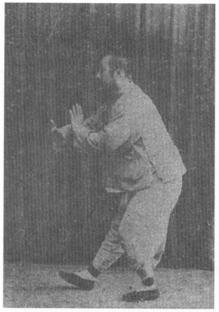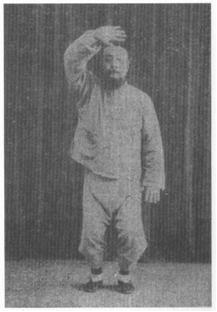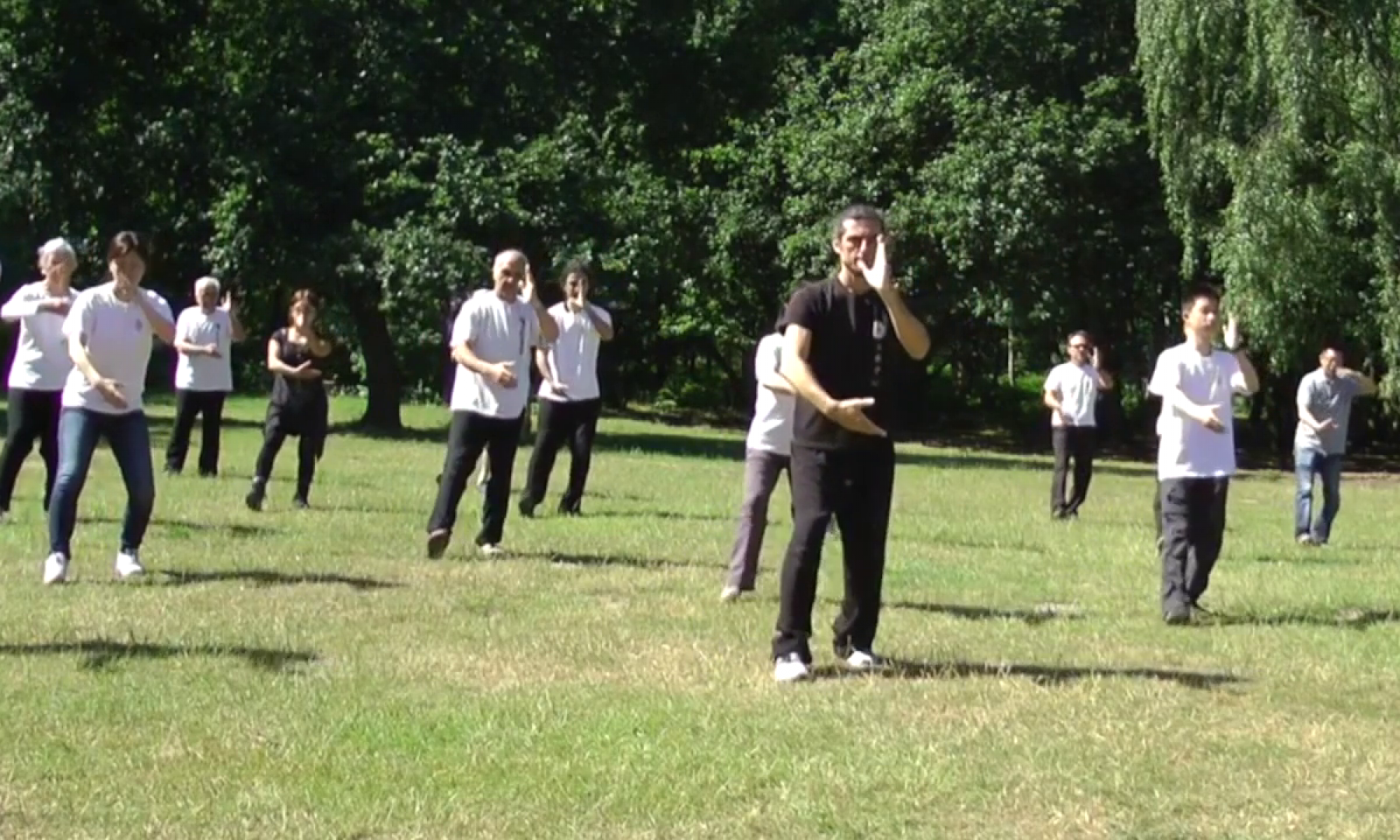tí shǒu shàng shì 提手上势 raise hand and step up
九 提手上勢(一)
9. RAISE THE HANDS (part 1)
左脚尖挪向正南,zuǒ jiǎo jiān nuó xiàng zhèng nán Your left foot turns to point the toes to the south,
全身坐於左腿。quán shēn zuò yú zuǒ tuǐ the weight shifting fully onto your left leg,
左手依原式攏向胸前;zuǒ shǒu yī yuán shì lǒng xiàng xiōng qián while your left hand, remaining an upright palm, gathers in to be in front of your chest,
視綫隨之。shì xiàn suí zhī your gaze going along with it,
右手鷹爪伸開,yòu shǒu yīng zhuǎ shēn kāi and your right hand opens its eagle’s claw,
隨臂下沉,攏向東南方,suí bèi xià chén lǒng xiàng dōng nán fāng the arm sinking, gathers in toward the southeast,
略成半圜形,luè chéng bàn yuán xíng the arm making a curved shape,
成陰掌,chéng yīn zhǎng the hand becoming a passive [inward] palm
與左手縱橫環抱。yǔ zuǒ shǒu zòng héng huán bào perpendicular to your left hand as if holding something.
同時右脚提起,tóng shí yòu jiǎo tí qǐ At the same time, your right foot lifts,
挪向東南,nuó xiàng dōng nán shifts to the southeast,
成虚步。chéng xū bù and makes an empty stance,
脚尖南指。jiǎo jiān nán zhǐ toes to the south.
眼看南方。yǎn kàn nán fang Your eyes are looking to the south.
如圖九正面側面兩圖。rú tú jiǔ zhèng miàn cè miàn liǎng tú
See photo 9, both forward and side views:

一〇 提手上勢(二)
10. RAISE THE HANDS (part 2)
身向前傾。shēn xiàng qián qīng Your torso inclines forward,
右脚落實成弓步。yòu jiǎo luò shí chéng gōng bù your right foot lowering fully and making a bow stance, {right foot sinks solid to become a bow stance}
右臂徐向上提;yòu bèi xú xiàng shàng tí while your right arm slowly lifts up,
左手則同時下沉,zuǒ shǒu zé tóng shí xià chén
與臂成垂直線,yǔ bèi chéng chuí zhí xiàn
your left hand sinking until the arm hangs straight down,
指尖上翹。zhǐ jiān shàng qiào fingers lifted.
左手提至額部之上,zuǒ shǒu tí zhì é bù zhī shàng Your left [right] hand lifts until above your forehead,
轉成陽掌,zhuǎn chéng yáng zhǎng rotating to become an active [outward] palm,
手背距額部約一拳許。shǒu bèi jù é bù yuē yī quán xǔ the back of the hand about a fist’s distance from your forehead,
左脚移前,zuǒ jiǎo yí qián while your left foot shifts forward
與右脚並立,yǔ yòu jiǎo bìng lì to stand next to your right foot,
成平行步。chéng píng xíng bù making a parallel stance,
兩腿微彎。liǎng tuǐ wēi wān both legs slightly bent.
眼看南方。yǎn kàn nán fang Your eyes are looking to the south.
如圖一〇。rú tú yī ling See photo 10:


From the weight all on the left, bring the left arm up high as the body is brought back to vertical, dropping the lower back to get a spinal stretch. This encourages good push hands technique.
To help with a strong shoulder barge (kào) be sure to spiral the LH strongly (L thumb turning down slightly). Keep the body square to ensure the shoulder and not the back is used. Lean heavily into the L leg support with the R hand pushing down in front of the R hip bone.
When the L hand is behind the R hand the L hand turns palm out and pushes against the palm of the R hand (this would already be resting against the opponent). (jǐ – squeeze/press)
APPLICATIONS
If the OP is pushing both hands to your R arm, raise it (lv), then push (an) with LH.
If OP is pushing toward your belly/chest, trap their arm between your L&R go for the joints (wrist / elbow/ under shoulder) as dictated by the situation.